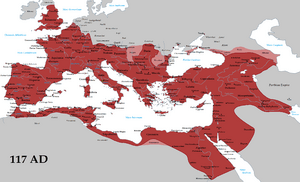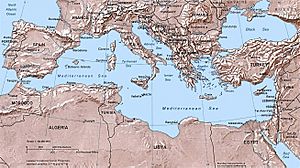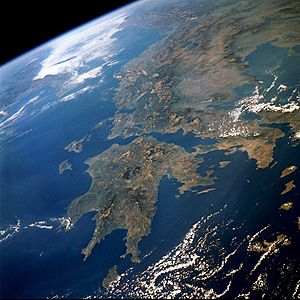Mediterranean Sea facts for kids
The Mediterranean Sea is a large body of water that separates three continents: Europe to the north, Africa to the south, and Asia to the east. It's almost completely surrounded by land.
This sea connects to the Atlantic Ocean through a narrow passage called the Strait of Gibraltar. This strait is located between the southern tip of Spain and northern Morocco. The Mediterranean Sea covers a huge area, about 2.5 million square kilometers (965,000 square miles).
To the east, it connects to the Sea of Marmara and the Black Sea. These connections are made through two narrow waterways: the Dardanelles and the Bosporus. While the Sea of Marmara is often seen as part of the Mediterranean, the much larger Black Sea usually isn't.
There's also a man-made connection to the Red Sea in the southeast. This is the 163-kilometer (101-mile) long Suez Canal. It sits between Egypt and the Sinai Peninsula. The French Compagnie Universelle du Canal Maritime de Suez built this canal between 1859 and 1869.
A Sea of History

Many of the world's oldest human civilizations grew up around the Mediterranean Sea. Because of this, the sea has had a huge impact on their cultures and ways of life. It was a vital pathway for trade, for people to settle new lands, and even for war. For many communities throughout history, the sea was also a main source of food, like fishing and catching other seafood.
The shared climate, geology, and easy access to this common sea created strong historical and cultural links. These connections exist between ancient and modern societies all around the Mediterranean.
In ancient times, the Mediterranean was like a superhighway for transport. It made it easy for different peoples to trade and share ideas. Groups like the Phoenicians, Egyptians, Carthaginians, Greeks, Romans, and people from the Middle East all used the sea.
The history of the Mediterranean is key to understanding how Western civilization began and grew. More recently, during World War II, many important sea battles happened here. Controlling the Mediterranean was very important for defeating the Axis Powers, which included Nazi Germany and Italy.
Even today, the Mediterranean Sea still connects the economies of Europe, North Africa, and the Middle East. Just like in ancient times, it remains a busy route for ships and goods. Sadly, in recent years, many people seeking new homes have faced dangers while crossing the Mediterranean Sea.
About the Water
Because the Mediterranean Sea is almost completely surrounded by land, its water has some unique features. For example, the tides here are not very strong. This is because of the narrow connection to the Atlantic Ocean. The water in the Mediterranean is also saltier than the Atlantic. This is partly due to a lot of evaporation happening on its surface. The Mediterranean is also famous for its beautiful deep blue color.
More water evaporates from the Mediterranean than it gets from precipitation (rain and snow) or rivers flowing into it. This is a very important fact for how the water moves around the sea. Evaporation is especially high in the eastern part of the sea. This causes the water level to drop and the salinity (saltiness) to increase towards the east.
This difference in pressure pushes cooler, less salty water from the Atlantic into the Mediterranean. As this water travels east, it gets warmer and saltier. Then, it sinks in the eastern part of the sea, near the Levant. From there, it flows westward, eventually spilling back into the Atlantic through the Strait of Gibraltar. This means water flows eastward on the surface of the Strait and westward deeper down. This special "Mediterranean Intermediate Water" can travel thousands of kilometers into the Atlantic Ocean.
Images for kids
-
The Battle of Lepanto, 1571, a victory for the European Holy League against the Ottoman Turks.
-
The bombardment of Algiers by the Anglo-Dutch fleet in 1816.
-
Alexandria, the largest city on the Mediterranean.
-
Barcelona, the second largest metropolitan area on the Mediterranean Sea.
-
The Acropolis of Athens with the Mediterranean Sea in the background.
-
The ancient port of Jaffa (now in Tel Aviv-Yafo), from which the biblical Jonah set sail.
-
Catania, Sicily, Italy, with Mount Etna in the background.
-
Positano, Italy, Tyrrhenian Sea.
-
Sarandë, Albania, on an open-sea gulf of the Ionian sea.
-
A thermonuclear bomb that fell into the sea recovered off Palomares, Almería, 1966.
-
Stromboli volcano in Italy.
-
The reticulate whipray is one of the species that colonised the Eastern Mediterranean through the Suez Canal.
-
A cargo ship cruises towards the Strait of Messina.
-
Port of Trieste.
-
Kemer Beach in Antalya on the Turkish Riviera.
-
Coast of Alexandria, view From Bibliotheca Alexandrina, Egypt.
-
Sardinia's south coast, Italy.
-
View of Neum, Bosnia and Herzegovina.
-
Paphos, Cyprus.
-
Burj Islam Beach, Latakia, Syria.
-
A view of Raouché off the coast of Beirut, Lebanon.
-
A view of Haifa, Israel.
-
Europa Point, Gibraltar.
See also
 In Spanish: Mar Mediterráneo para niños
In Spanish: Mar Mediterráneo para niños

















































